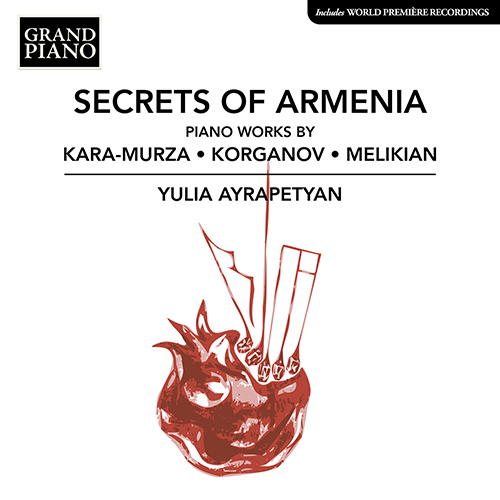
About this Release
“The album Secrets of Armenia, featuring selected piano works by Kara-Murza, Korganov, and Melikian, is a reflection of the mentality of the Armenian people through the prism of dance and songs that have their origin in everyday scenes of the people’s life. My favourite work in this album is Emerald Songs by Romanos Melikian for its emotional expressivity and extreme originality, and Melikian’s individuality itself above all through his rare organic unity of poetry and music.” — Yulia Ayrapetyan
SECRETS OF ARMENIA
Kara-Murza • Korganov • Melikian
- Yulia Ayrapetyan, piano
The music in this collection reflects the spirit of Armenia through dances and songs that have their origins in scenes from everyday Armenian life. Korganov’s pictorial Bayati is an especially vivid representation, while Kara-Murza’s Pot-pourri sur des airs arméniens is a significant work, combining Armenian folk music with the Western piano tradition. Melikian’s Emeralds is one of his famous cycles of romances, hallmarked by a strong sense of poetic narrative and a vivid emotional expressiveness. This album of Armenian piano discoveries is played by Yulia Ayrapetyan, a specialist in the music of Armenia.
Tracklist
|
Kara-Murza, Kristapor
|
|
1
Pot-pourri sur des airs arméniens, Op. 11 () (00:10:47)
|
|
2
Marche funèbre (1890) (00:06:47)
|
|
Korganov, Genary
|
|
3
Bayati (1887) (00:06:01)
|
|
4
Rhapsodie arménienne, Op. 15 (1892) (00:10:17)
|
|
Melikian, Romanos
|
|
Zmrukhti (Emeralds) (arr. V. Sargsyan for piano) (1920) (00:16:00 )
|
|
5
No. 1. Black Partridge (00:01:38)
|
|
6
No. 2. The Night Has Come (00:02:35)
|
|
7
No. 3. The Infant and the Brook (00:01:36)
|
|
8
No. 4. Don't Cry (00:01:55)
|
|
9
No. 5. You Shine (00:02:14)
|
|
10
No. 6. I am a Nightingale (00:02:17)
|
|
11
No. 7. Sprout (00:01:21)
|
|
12
No. 8. Lullaby (00:01:49)
|
|
13
Vard (The Heathrose) (arr. V. Sargsyan for piano) (1912) (00:02:34)
|
|
14
Ashun (Autumn Song) (arr. V. Sargsyan for piano) (1912) (00:02:05)
|
|
15
Sare Gyalin (Red-Haired Bride) (arr. V. Sargsyan for piano) (1913) (00:02:46)
|
The Artist(s)
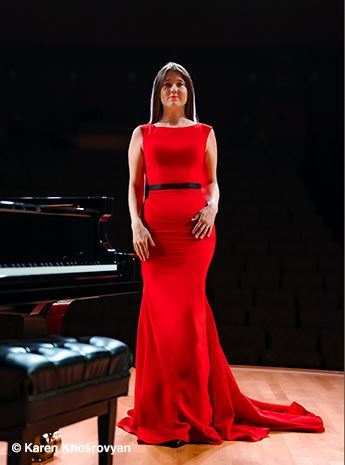 Yulia Ayrapetyan is a US-based pianist, producer and pedagogue. She has attracted international recognition for her exceptional artistry, displaying striking assurance, imagination, artistic approach, and remarkable consistency in the musical integrity and creative insight of her performances. Born in 1988 in Bryansk, Russia, she studied in Moscow, and continues to uphold the performing traditions of the Russian piano school. Her repertoire ranges from the Baroque to the contemporary and includes rarely performed works by Armenian composers. She performed the US, Chinese, Europe, Russian and Armenian premieres of forgotten Armenian piano music, which she rediscovered. She actively supports and participates in recordings and concerts for her husband Mikael Ayrapetyan’s project, Secrets of Armenia.
Yulia Ayrapetyan is a US-based pianist, producer and pedagogue. She has attracted international recognition for her exceptional artistry, displaying striking assurance, imagination, artistic approach, and remarkable consistency in the musical integrity and creative insight of her performances. Born in 1988 in Bryansk, Russia, she studied in Moscow, and continues to uphold the performing traditions of the Russian piano school. Her repertoire ranges from the Baroque to the contemporary and includes rarely performed works by Armenian composers. She performed the US, Chinese, Europe, Russian and Armenian premieres of forgotten Armenian piano music, which she rediscovered. She actively supports and participates in recordings and concerts for her husband Mikael Ayrapetyan’s project, Secrets of Armenia. The Composer(s)
Reviews
“The music of Armenia gets impressive advocacy from Yulia Ayrapetyan on a release that should appeal to lovers of rare repertoire… highly effective piano transcriptions… The music of Emeralds is extremely attractive” – International Piano

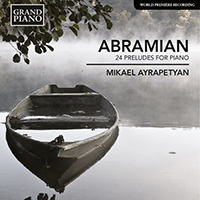
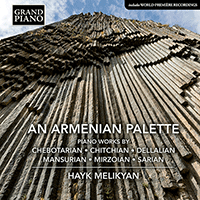
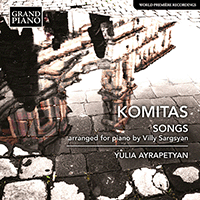
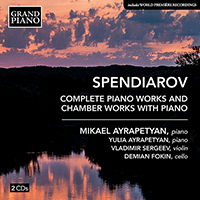
 Grand Piano has gained a reputation for producing high quality recordings of rare keyboard gems. Dedicated to the exploration of undiscovered piano repertoire, the label specialises in complete cycles of piano works by many lesser-known composers, whose output might otherwise have remained unknown and unrecorded.
Grand Piano has gained a reputation for producing high quality recordings of rare keyboard gems. Dedicated to the exploration of undiscovered piano repertoire, the label specialises in complete cycles of piano works by many lesser-known composers, whose output might otherwise have remained unknown and unrecorded.






